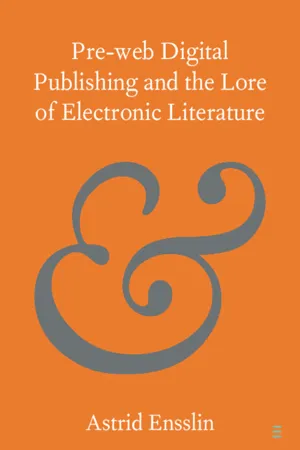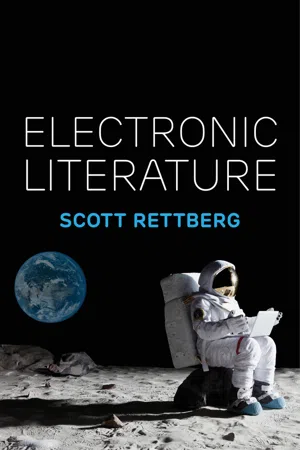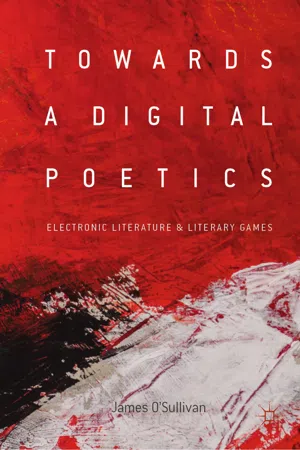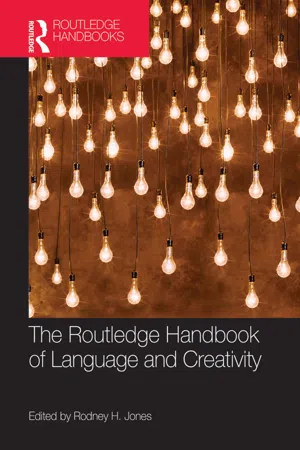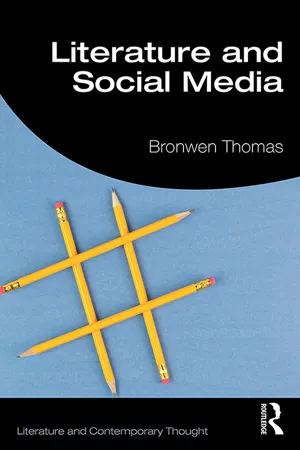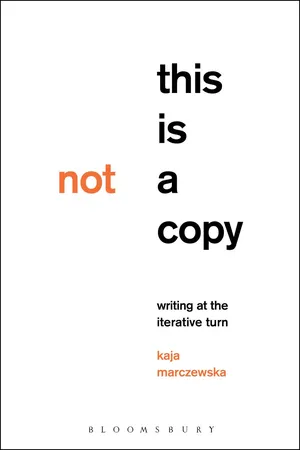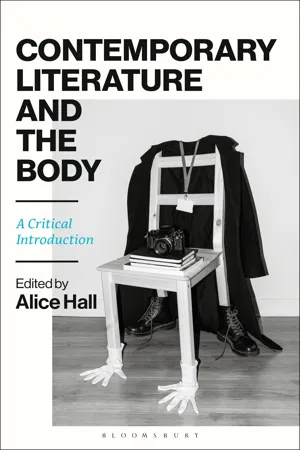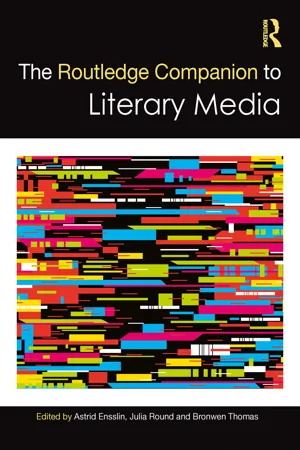Literature
Electronic Literature
Electronic literature refers to literary works created and experienced on digital platforms, often incorporating multimedia elements such as hypertext, animation, and sound. It encompasses a wide range of genres and forms, including interactive fiction, poetry, and kinetic typography. Electronic literature challenges traditional notions of textuality and offers new modes of storytelling and reader engagement.
Written by Perlego with AI-assistance
Related key terms
1 of 5
11 Key excerpts on "Electronic Literature"
- eBook - PDF
Memory Bytes
History, Technology, and Digital Culture
- Lauren Rabinovitz, Abraham Geil, Lauren Rabinovitz, Abraham Geil(Authors)
- 2004(Publication Date)
- Duke University Press Books(Publisher)
What is Electronic Literature? As Marjorie Luesebrink notes, it is a concept still slouching toward definition. 2 Among those who regard literature as a form of essential and authentic experience, there is a persistent historical tendency to vilify ‘‘technology’’—including computer-based digital technologies—as a corrupting force. Alter-natively, among those who champion the use of technology in the creation of literature, the tendency has been to glorify it as a form of liberation for both writers and audiences alike. 3 Among writers and critics in both camps, their narratives embody profound de-sires, hopes, anxieties, and fears about digitally based literature. These narratives have less to do with ‘‘technology’’ and more to do with ‘‘culture’’—in this case, literary culture. They are a response to the growing Electronic Literature community that in complex ways—in addition to the ever-quickening development of digital technologies, more powerful authoring software, and in-creasingly sophisticated work—brings together artists, graphic de-signers, sound technicians, musicians, and computer programmers. This new community constitutes an artistic underground, an avant-garde literary movement that alternately challenges and ignores the institutional apparatus for ‘‘traditional’’ or ‘‘mainstream’’ litera-ture. 4 In the broadest sense, Electronic Literature includes all writing that is produced in digital form. This would include everything from the reproduction of, say, Shakespeare’s plays on the Web, to Sylvia Plath’s poems reproduced for reading on newly developed electronic devices such as the Rocket e-Book. It would also include Stephen King’s novel The Plant , which was downloaded from the Internet and paid for by readers in installments, starting in the summer of 2000. King’s experiment brought a lot of public atten-tion to developments in digital technology, to their impact on the materiality of texts, and to the economics of publishing. - Astrid Ensslin(Author)
- 2022(Publication Date)
- Cambridge University Press(Publisher)
I close with a more detailed examination of how lore can be under- stood as a critical tool for subverting entrenched political and societal structures and as a systematic method of qualitative participant research. 1.1 Conceptual Framework and Terminology According to an early (2006) definition proposed by the Electronic Literature Organization, e-literature is an art form that “works with impor- tant literary aspects that take advantage of the capabilities and contexts provided by the standalone or networked computer” (quoted in Rettberg 2019: 4). It is born digital in the sense that it is “written for and read on a computer screen [and] pursues its verbal, discursive and/or conceptual complexity through the digital medium, and would lose something of its aesthetic and semiotic function if it were removed from that medium” (Bell et al. 2010). Electronic Literature pushes the boundaries of digital media’s 4 Publishing and Book Culture technical and material affordances, often critiquing and subverting their corporate, neoliberal underpinnings. Common experimental forms include hypertext and hypermedia; interactive fiction; literary video games and touchscreen apps; kinetic, generative, bot, and sound poetry; locative, ambient, and virtual reality/augmented reality (VR/AR) works; and social media literature such as Instapoetry and Twitterature as well as site-specific installations (Rettberg 2019). The list continuously evolves as new plat- forms and technologies become available, and much e-literature either programmatically defies genre categorization or becomes genre-defining retroactively. What exactly “literature” and “literary” refer to is of course a moot point. Many works created and studied by members of the e-literature community do not have any written element to them, contrary to the original meaning of the Latin litterae (letters and other types of written documents) (Ensslin 2014).- eBook - ePub
- Scott Rettberg(Author)
- 2018(Publication Date)
- Polity(Publisher)
Electronic Literature provides a genre-driven approach to the corpus of Electronic Literature, albeit one that calls for a reconsideration of what qualities distinguish a creative genre in contemporary networked culture, as this may differ from traditional notions of genre in literature, art, and media studies. Genre in Electronic Literature is complicated by the interdisciplinary nature of the field and perhaps most importantly by the fact that it is driven in equal measure by cultural and technological contexts. While the authors and artists working in the field are informed by the historical influence of other arts disciplines and practices, their work is equally shaped and delimited by technological innovation. The software and platforms used to develop works of Electronic Literature constrain and afford properties of these emergent genres in significant ways.While Electronic Literature must be read from a standpoint of media and platform-specificity, these new literary genres did not emerge from a cultural vacuum, but in response to and in conversation with literary and artistic traditions. The various genres of Electronic Literature such as hypertext fiction, kinetic poetry, combinatory poetics, interactive fiction, networked-based collective narrative, locative narrative, interactive textual installations, and interactive cinema in fact owe significant debts to specific twentieth-century literary and avant-garde movements such as Dada, Surrealism, modernism and postmodernism, Situationism, Fluxus, and others. This book tries to frame the emerging genres of Electronic Literature within these historical contexts, enabling better understanding of the continuity of literary and artistic practice as well as the innovation enabled by new technologies.Defining Electronic Literature
The term “Electronic Literature” is controversial within the field itself. Detractors of the term claim that it is not specific enough – after all “electronic” refers essentially to any device powered by electricity, and the boundaries of “literature” are equally murky. Others prefer that “digital literature” should refer to roughly the same body of work. John Cayley (2002) offers “writing in networked and programmable media” as a more specific term. “E-Poetry” and “hypertext” also have their specific adherents, and Aarseth’s “cybertext” is a narrower term for texts with specific interactive properties. A key advantage of the term “Electronic Literature” is its generality, and thus its ability to include those emerging genres that did not exist in the 1990s, when the term was first widely circulated. This may have contributed to the term’s longevity. - eBook - ePub
Towards a Digital Poetics
Electronic Literature & Literary Games
- James O'Sullivan(Author)
- 2019(Publication Date)
- Palgrave Macmillan(Publisher)
Electronic Literature’s structural relationship with computation, which evolves at an exponential rate, is such that the form will never be static; thus, our only alternative is to cast a wide taxonomic net, and resolve peculiarities as they arise. Electronic Literature is that which combines the electronic, the screen—digital or otherwise—with the literary, presenting, often through a multiplicity of modes, an assemblage that might privilege either, but will always feature, these two essential elements. That is all it is, and to say so might not really tell us anything. But like literature, we know it when we see it. The Emergence of Electronic Literature The theme for the Electronic Literature Organization’s 2015 gathering in Bergen was “the ends of Electronic Literature”. Anastasia Salter explains that this theme emerged from the realisation that the digital is no longer other, and so we should abandon terms that reassert old distinctions: Is the choice to use words like “electronic” or “digital” to designate our work and pedagogy simply a reflection of a moment of transition, soon to be abandoned as such methods become universal, or is it still important to call attention to the use of technology as we push it towards new frontiers? (Salter 2015) It is true to say that Electronic Literature is literature, but to suggest that we have moved to a point where distinction is no longer valid seems premature. There are dead technologies and there are technologies yet to be born—there are practices considered Electronic Literature by some, and not by others - Rodney H. Jones, Rodney Jones, Rodney H. Jones(Authors)
- 2015(Publication Date)
- Routledge(Publisher)
The most popular misconception is to understand text appearing in digital media as digital text or, to use the concept more important for the discussion at hand, digital literature. This is not very different from saying that a story read on the radio is a radio play. To avoid such misconceptions, it has been asserted that digital literature should be ‘born digital’. However, this stricture does not help much if it is understood as a requirement to create the text on or using a computer: typing a novel using a keyboard and reading it on the screen does not turn it into digital literature. The Electronic Literature Organization (ELO), founded in 1999 ‘to foster and promote the reading, writing, teaching, and understanding of literature as it develops and persists in a changing digital environment’, tries to be more precise when answering the question of what is Electronic Literature: ‘Electronic Literature, or e-lit, refers to works with important literary aspects that take advantage of the capabilities and contexts provided by the stand-alone or networked computer’ (ELO, 1999). This definition introduces a second problem – without really solving the first – by shifting from ‘ digital environment’ to ‘ Electronic Literature’. Leaving alone the troubled waters of ‘important literary aspects’, a poem using the distribution facility of email or weblogs – thus taking advantage of the capabilities of a networked computer – is still a poem. No matter how we eventually define the specific ‘literariness’ of digital literature, it is evident that it undermines the identity of digital literature as literature. In addition to the sine qua non of literariness, there is another sine qua non regarding the essence of digital literature: that it is more than literature in the traditional sense. By definition, digital literature has to go beyond the employment of letters and it has to make aesthetic use of the features of digital media- eBook - ePub
- Bronwen Thomas(Author)
- 2020(Publication Date)
- Routledge(Publisher)
Both the theory and practice of Electronic Literature also demonstrate a close connection with performance and gaming. For example, Ensslin’s (2014) work situates itself on a ‘literary- ludic spectrum’, arguing both for the literariness of some videogames and for the game-like qualities of digital fictions. Although Electronic Literature is now about much more than words and text, a strong focus on language and formal experimentation persists. Creators of hypertext fiction and early forms of Electronic Literature not only perceived themselves to be in the vanguard of experimentation with literary form, but also had to be technically proficient, understanding code and software as well as the commercial imperatives affecting the distribution and uptake of their works. Novelistic representations of computers and communication technologies from the same period primarily portrayed them as mechanistic or alienating, a threat to culture and civilisation, or as the trigger for comic scenes based on the ineptitude of users (Thomas 2012). By the end of the twentieth century, however, there is undoubtedly a growing sense of inevitability about the role of technology in the production and consumption of literary texts, with computers becoming less of a curiosity and more of a necessity for writers. Interviewed in 2000, Martin Amis admitted to relying more and more on his computer, despite describing this shift as ‘sinister’, and bemoaning the loss of the ‘slightly painterly feel’ of writing in longhand (Richards 2000) - eBook - PDF
Reading Moving Letters
Digital Literature in Research and Teaching. A Handbook
- Roberto Simanowski, Jörgen Schäfer, Peter Gendolla, Roberto Simanowski, Jörgen Schäfer, Peter Gendolla(Authors)
- 2015(Publication Date)
- transcript Verlag(Publisher)
I think that’s what most of us mean, even if we’ve come to it in an ad-hoc way. To take the other term in my initial phrase, “digital literature” could be used in the sense of “the literature” (the body of scholarly work on a topic) or it could mean particularly high-status writing—but I mean “literature” (and “literary”) as a way of referring to those arts we sometimes call fiction, poetry, and drama (as well as their close cousins). I mean the arts that call our atten-tion to language, present us with characters, unfold stories, and make us reflect on the structures and common practices of such activities. I should probably also say that I don’t view the literary arts as a citadel, separate (and perhaps in need of defense) from, say, visual or performing arts. Much of the best drama, for example, brings together the literary, performing, and visual arts. To me, “digital art” is the larger category of which “digital literature” is a part. It encompasses all the arts that require digital computation, not just the literary arts. I write all this because, as an artist and scholar in the field of digital litera-ture, I’ve begun to try to think more generally about the field of which I’m a part. I do this on one level because I’m curious about certain topics. For ex-ample: Where did this field begin? But at a deeper level I’m interested in ques-tions of how we conceptualize what we make and study. The question that motivates my writing here is one of these: What might be a useful framework for thinking about the elements and context of works of digital literature? To put it another way: What do we need to read, to interpret, when we read digital literature? Noah Wardrip-Fruin | Five Elements of Digital Literature 30 2 Turing, Strachey, Love Letters 2.1 Turing Machines get Electronic When I say that I mean “digital” as in “stored program electronic digital com-puter,” what does that mean, more precisely? In 1937 everyone who used the term “computer” knew what it meant. - eBook - PDF
This Is Not a Copy
Writing at the Iterative Turn
- Kaja Marczewska(Author)
- 2018(Publication Date)
- Bloomsbury Academic(Publisher)
While the field I focus on here is eclectic and generically diverse, the texts discussed have in common a characteristic commitment to systems and processes, an interest in how things are done rather than the things themselves. As Nick Montfort and Stephanie Strickland stress, “Electronic Literature and digital art need to be studied by operating them, examining CODE 181 not only their outputs but also their interfaces.” 9 My focus on electronic writing stems from a similar understanding of its dynamics and a related interest in the possibilities of writing by iterative means that electronic environments create. Key to my argument is a recognition that although examples of computer-generated poetry might seem like a simple remediation from a printed page to a computer screen, the texts are built on a much more complex model of cultural production. As Glazier emphasizes it is important to note that that digital poetries are not merely print poetry repositioned in the new medium. Instead, e-poetries extend the investigation of innovative practice as it occurred in print media, making possible the continuation of lines of inquiry that could not be fulfilled in that medium. 10 Electronic Literature offers, to quote Morris, “a new order of writing,” 11 or, as Strickland describes it, a “next staging” rather than a recapitulation, on-screen, of earlier experimental poetry methods and techniques. 12 The confluence of avant-garde and new media thinking that transpires in both Glazier’s and Strickland’s statements is characteristic of current approaches toward computer-generated writing and, hence, of particular relevance to this book. - eBook - ePub
Contemporary Literature and the Body
A Critical Introduction
- Alice Hall(Author)
- 2023(Publication Date)
- Bloomsbury Academic(Publisher)
4 Electronic Literature Elizabeth LoshFor many decades, Electronic Literature was best known for producing works in emerging genres that were designed primarily for desktop computers. Text and images usually appeared on a monitor positioned in front of the user. Although the experience of reading might require input from a keyboard or mouse that disrupted conventions about how the text was delivered for consumption by the eye, the substitution of screen for page did not radically reconfigure the relationship between the reader’s body and textual discourse, as the user progressed through her or his literary encounter with either a two-D hypertext page or a one-D output line of code.This did not mean that the body was not a matter of concern for pioneering digital authors. It might even be a central topic in a work, as is the case in Shelley Jackson’s My Body – a Wunderkammer (1997), in which the main navigation presents the reader with a choice of rectangles focused on different parts of a woman’s body. In exploring the different anatomical segments represented by woodcut illustrations, the reader learns intimate details about the narrator’s embodied experiences, such as what it feels like to have a nostril pierced or to be surprised by tender nipples during puberty.With a similar interest in fragmented subjectivity, Juliet Davis’s Pieces of Herself (2005) uses the trope of dressed-up paper dolls to structure a journey that interrogates the central figure’s sex, gender and female identity by constructing a massive collage selected from hundreds of digital photographs and audio clips. Using a drag-and-drop game interface, viewers scroll through conventional environments for gender play to collect ‘pieces’ of the self and arrange them inside an outline of a female body. As each piece enters the representation of feminine corporeality, it triggers audio derived from interviews with women, music loops or sound effects. Inspired by ‘Elizabeth Grosz’s theories about embodiment’, the author describes Pieces of Herself as a comment upon the ‘social inscription of the body’.1 - eBook - ePub
- Astrid Ensslin, Julia Round, Bronwen Thomas, Astrid Ensslin, Julia Round, Bronwen Thomas(Authors)
- 2023(Publication Date)
- Routledge(Publisher)
What is Literary Media? Astrid Ensslin, Julia Round and Bronwen ThomasDOI: 10.4324/9781003119739-1It has been over a decade since, in her groundbreaking book Electronic Literature: New Horizons for the Literary (2008 ), N. Katherine Hayles challenged the rigid, exclusive and somewhat obsolete institutional and ideological connotations of the term ‘literature’ in a fast-transforming media landscape. She called for a ‘broader category that encompasses the kind of creative … artworks that interrogate the histories, contexts and productions of literature, including as well the verbal art of literature proper’ (45). This proposed category, called ‘the literary’, reflects the seismic impact of contemporary digitalisation and the increasing cross-pollination of literary studies with such diverse disciplines and movements as media and cultural studies, social, environmental and computational sciences, pop, fan and participatory cultures.This volume situates its exploration of ‘literary media’ against this backdrop, asking what happens when we expand the horizons of what can be considered literary still further. Whereas Hayles’ concept still posits the literary as a distinct category, and confines itself to works that define themselves as creative/artistic, our definition of ‘literary media’ includes popular cultural forms and media and cultural texts that do not necessarily overtly align themselves to the literary. This may also include paratextual materials, and an approach and method that includes discussion of specific aspects of the socio-political, industry and commercial contexts, as well as analysis of specific texts or works. Fundamentally, instead of keeping the literary and the media as separate categories, we focus on an interdependence of the literary and its diverse forms of mediation that is increasingly apparent in this era of global late capitalism. The term ‘literary media’ for us therefore far exceeds notions and connotations of ‘art’ and unsettles the continuing privileging of ‘literature proper’. Our formulation derives from and has particular resonance for scholars working at the intersection of literary and media studies and reflects wider shifts in both institutional structures and the long established boundaries or silos of traditional academic disciplines. - eBook - PDF
Beyond the Screen
Transformations of Literary Structures, Interfaces and Genres
- Jörgen Schäfer, Peter Gendolla, Jörgen Schäfer, Peter Gendolla(Authors)
- 2015(Publication Date)
- transcript Verlag(Publisher)
Patrons of the Internet uni-versal library send a distracted page down into the holdings, where he tends to grab the books that are closest to the elevator doors. Electronic Literature benefits from tagging because it is the sign of readers engaged in the act of filling up their curiosity cabinets, their Uncle Buddy’s fun Joseph Tabbi | On Reading 300 Works of Electronic Literature 488 houses and their gardens of forking syllabi. That task becomes games since writing e-lit often involves creating that object which is difficult to tag. What appeals to me about your post is this sense of the diversity of elec-tronic literature—or its refusal to be categorized, and yet at this point Profes-sors of Letters who are attempting to create 21 st -Century syllabi do need a way to access the works, perhaps not a canon, but a database, and the ELD 2.0 should be one starting point. 11. Jan Baetens: 26 July 2009 at 5:43 pm As defined -and defended- by Joe Tabbi, the task of “tagging,” as a critical act in the two major meanings of the word (critique as a form of metalanguage, critique as a critical and theoretecal reflection on the stakes of this very task) is both very challenging and quite problematic. It is very challenging in the first place, since tagging may provide a prag-matic yet not unstructured answer to the difficulties raised by reading e-lit as well as to the lack of a “poetics” (Sandy Baldwin quoted by Tabbi). No reading is possible without any previous form of identification and awareness of the intertextual field in which it occurs. E-literature is no exception to this rule. Tagging can provide clues, certainly if the reviewers are conscious of their re-sponsibility and accept to take benefit of their tagging activity to shape the glossary of keywords that is still cruelly lacking for the reading of e-literature.
Index pages curate the most relevant extracts from our library of academic textbooks. They’ve been created using an in-house natural language model (NLM), each adding context and meaning to key research topics.

